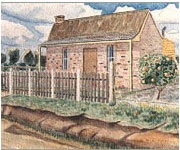Granny Smith
Who was Granny Smith?
 Photo: Maria Ann Smith and her eldest son Thomas (courtesy of Alan Smith)
Photo: Maria Ann Smith and her eldest son Thomas (courtesy of Alan Smith)
'Granny Smith' was born Maria Ann Sherwood in the rural parish of Peasmarsh, Sussex, England, in late 1799. Her father worked as an agricultural labourer and Maria also went into farm service. At the age of 19, she married Thomas Smith, a farm labourer from the neighbouring parish of Beckley. They were married in the small church at Ebony, across the border in Kent.
The Smiths lived in Beckley for the next 19 years, during which time Maria bore 8 children. In 1838 they and several other families from Peasmarsh, Beckley and surrounding villages were recruited by government agents looking for people with agricultural and trade skills sorely needed in the colony of New South Wales. The emigrant families arrived in Sydney on 27 November 1838 aboard the Lady Nugent.
Maria and Thomas were accompanied by their 5 surviving children, Thomas aged 16, Stephen 13, Charles 8, Sarah 6 and Maria Ann aged 1. On arrival in Sydney Thomas was engaged for £5 per year plus rations by Mr. Smart of Kissing Point [Ryde]. Smart was a wealthy Sydney auctioneer and land agent.
Family tradition suggests that Thomas also worked for some time on Major Edward Darvall's Ryedale estate [West Ryde]. Some connection to the Darvalls is certain since in 1844, Thomas Smith Jnr was working as a cook for Frederick Orme Darvall at South Creek. Thomas and his brother Stephen both settled at South Creek in the 1840s but continued to bring their children to St. Anne's at Ryde for baptism. It was at St. Anne's in 1842 that the Smiths' ninth child, William, was baptised in May 1842, aged 2 months.
Granny Smith's Farm
Image: Granny Smith's Home, North Road, Eastwood. Painted by A. Leslie Sotheron, around 1914
 In 1855 and 1856, Thomas Smith Snr bought 2 blocks of land [Lots 12 & 13] totalling around 24 acres on the edge of the Field of Mars Common. The farm lay between the present North Road and Abuklea Road, Eastwood, with its northern boundary midway between today's Irene Crescent and Longview Street and its southern boundary crossing Threlfall Street. The Smiths' house stood near the North Road boundary. When Thomas Smith died in 1876 he bequeathed the farm to his sons Thomas and Charles. Thomas sold Lot 12 to Edward Gallard in 1880 and Charles sold his portion to Gustave Hippolyte Duchateau in 1892. The Granny Smith Memorial Park marks part of the southern boundary of the farm.
In 1855 and 1856, Thomas Smith Snr bought 2 blocks of land [Lots 12 & 13] totalling around 24 acres on the edge of the Field of Mars Common. The farm lay between the present North Road and Abuklea Road, Eastwood, with its northern boundary midway between today's Irene Crescent and Longview Street and its southern boundary crossing Threlfall Street. The Smiths' house stood near the North Road boundary. When Thomas Smith died in 1876 he bequeathed the farm to his sons Thomas and Charles. Thomas sold Lot 12 to Edward Gallard in 1880 and Charles sold his portion to Gustave Hippolyte Duchateau in 1892. The Granny Smith Memorial Park marks part of the southern boundary of the farm.
The Granny Smith Apple
Thomas and Maria Smith, like their neighbours, were orchardists. From the earliest days of European settlement the district of Ryde had enjoyed a reputation for fruit growing. Oranges, apricots, grapes, peaches, strawberries, nectarines, apples and pears all flourished. Some orchardists specialised in fruit varieties of their own raising, including seedling apples. One such was the Granny Smith. The earliest account of the origin of the Granny Smith appeared in the Farmer and Settler of 25 June 1924, in an article by Herbert Rumsey, a Dundas orchardist and local historian. He interviewed local fruit-grower Edwin Small who recalled that in 1868 he and his father had been invited by Maria to examine a seedling apple growing by a creek on her farm. She explained that the seedling had developed from the remains of some French crab apples grown in Tasmania. The Granny Smith is today recognised as a fixed mutation or 'sport'.
Maria Smith died in 1870. Her apple never became a commercial variety in her lifetime but continued to be cultivated by local orchardists. It was exhibited as 'Smith's seedling' in the 1890 Castle Hill Agricultural and Horticultural Show. In the 1891 show 'Granny Smith's seedlings' took out the prize for cooking apples. By 1892 many growers were exhibiting 'Granny Smith's'.
In 1895 Albert H. Benson, Fruit Expert for the NSW Department of Agriculture, named 'Granny Smith's Seedling' as a suitable variety for export. He also initiated the first large scale cultivation of the apple at the Government Experimental Station in Bathurst.
Maria Ann Smith died on 9 March 1870 and was buried in St. Anne's Cemetery, Ryde. Her husband died six years later. Their headstone still stands in the churchyard.
Written by John Spurway, great-great grandson of Granny Smith and Megan Martin, former Local Studies Librarian at Ryde Library & Information Services, October 1992.